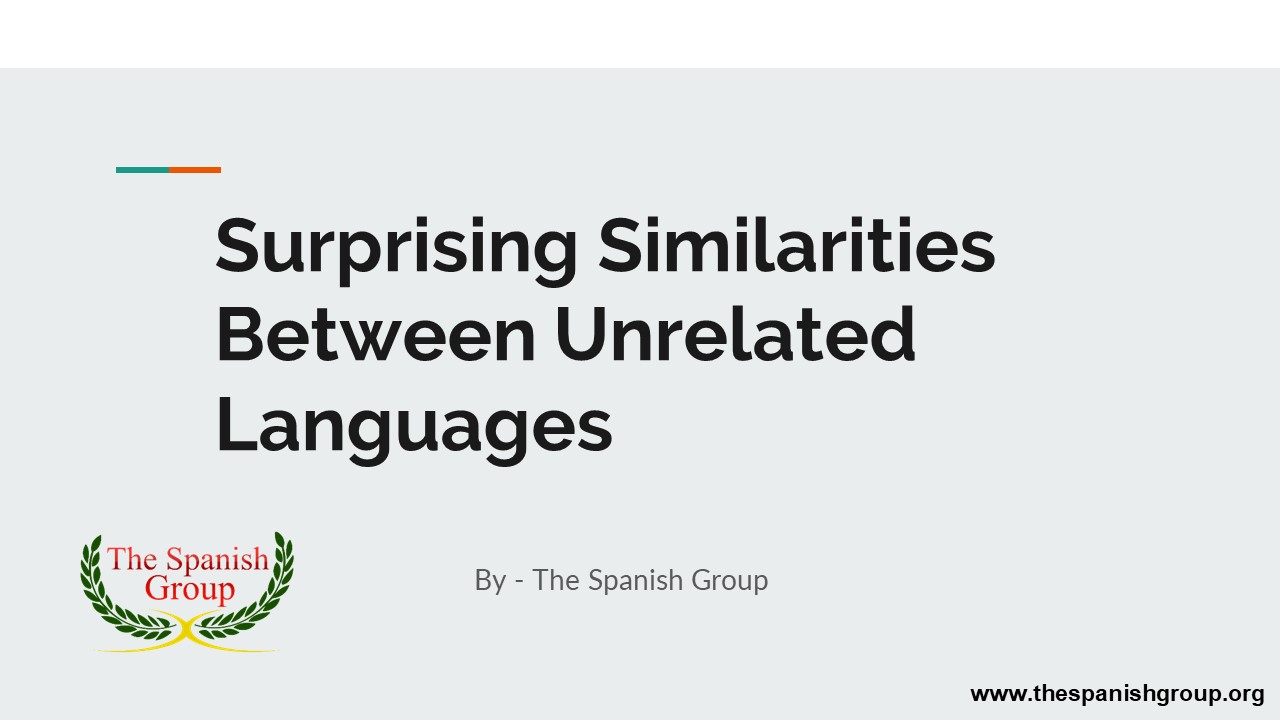Surprising Similarities Between Unrelated Languages - PowerPoint PPT Presentation
Title:
Surprising Similarities Between Unrelated Languages
Description:
The world of languages is a rich and diverse tapestry, with each language offering unique insights into human culture and cognition. Surprising similarities between unrelated languages remind us of the interconnectedness of humanity and the incredible capacity of our species to develop sophisticated communication systems. While these resemblances may not always have a clear explanation, they highlight the universality of some linguistic concepts and the enduring fascination of the study of language. – PowerPoint PPT presentation
Number of Views:2
Title: Surprising Similarities Between Unrelated Languages
1
Surprising Similarities Between Unrelated
Languages
- By - The Spanish Group
www.thespanishgroup.org
2
- Language is a fascinating and complex human
invention that allows us to communicate our
thoughts, feelings, and ideas with one another.
While it's widely accepted that languages evolve
independently over time, it's astonishing to
discover that some unrelated languages share
unexpected similarities. These resemblances can
provide insights into the human capacity for
language development and the interconnectedness
of our world. In this blog post, we'll explore
some of the most surprising similarities between
languages from different language families.
3
- Convergent Evolution
One of the most intriguing aspects of language
is its ability to evolve independently in
different parts of the world. This phenomenon is
known as "convergent evolution." Just as animals
in different ecosystems may develop similar
traits to adapt to their environments, languages
can independently develop similar features due to
shared needs or cultural influences. For
example, consider the striking similarity between
the word for "mother" in unrelated languages. In
English, it's "mother," while in Russian, it's "
????" (mat'). In Swahili, it's "mama," and in
Mandarin Chinese, it's "??" (māma). Despite the
linguistic and cultural differences between these
languages, the word for "mother" shares an
uncanny resemblance.
4
Onomatopoeia
Onomatopoeia refers to words that imitate the
sounds they describe. Surprisingly, some
onomatopoeic words have similarities in unrelated
languages. Take, for example, the sound a dog
makes. In English, it's "woof," while in
Japanese, it's "???? (wan-wan). Both languages
employ a doubling of the word, which seems to
mimic the repetitive barking of a dog. It's
remarkable that languages as diverse as English
and Japanese use similar patterns for
onomatopoeic words. Numerical Systems Another
area where unrelated languages exhibit unexpected
similarities is in their numerical systems. For
instance, the number "two" in English is similar
to its counterparts in many other languages. In
Russian, it's "???" (dva), and in Spanish, it's
"dos." This convergence is not due to shared
linguistic ancestry but rather a reflection of
the human tendency to use simple sounds for basic
numerical concepts.
5
Color Terminology
The way languages categorize and describe colors
can also reveal striking similarities. For
instance, many languages have basic color terms
for "red," "blue," and "green." Even though the
specific shades and nuances may differ, the
underlying structure of color terminology often
aligns. This suggests that there are universal
aspects of human perception that shape the
development of color vocabulary in languages
around the world.
Grammar and Syntax
While vocabulary may differ significantly between
unrelated languages, some underlying grammatical
structures and syntactical features can be
surprisingly similar. For example, many languages
use word order to convey meaning.
Subject-verb-object (SVO) word order is common in
languages as diverse as English, Mandarin
Chinese, and Swahili. This shared grammatical
structure suggests that certain language patterns
are more efficient for communication and are
therefore independently developed in unrelated
languages.
6
The world of languages is a rich and diverse
tapestry, with each language offering unique
insights into human culture and cognition.
Surprising similarities between unrelated
languages remind us of the interconnectedness of
humanity and the incredible capacity of our
species to develop sophisticated communication
systems. While these resemblances may not always
have a clear explanation, they highlight the
universality of some linguistic concepts and the
enduring fascination of the study of language.
At The Spanish Group, we understand the power of
language to connect people, businesses, and ideas
across borders. Our dedicated team of experienced
linguists and translators is here to help you
break down language barriers and unlock new
opportunities.
Source URL - https//thespanishgroup.org/blog/surp
rising-similarities-between-unrelated-languages/
7
Thank You
- Contact Info
- 1 800-460-1536
- www.thespanishgroup.org
- info_at_thespanishgroup.org
- We will be Glad if you visit us!
www.thespanishgroup.org































